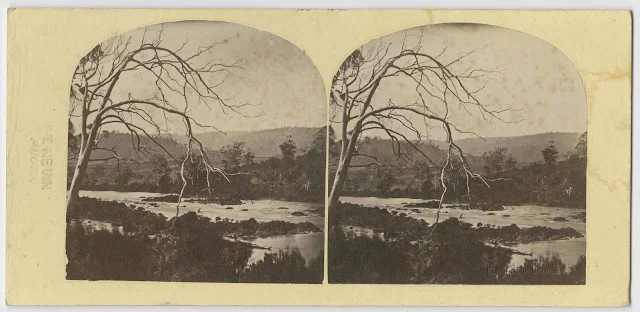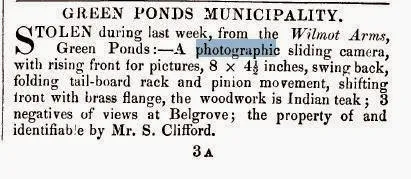GOVERNMENT CONTRACTOR photographer T. J. NEVIN
DISPERSAL and SUPPRESSION of archival records
The Archives Office of Tasmania collection
Online until recently, the Archives Office of Tasmania digitized and displayed 92 copies of the carte-de-visite photographs of Tasmanian convicts held at the Queen Victoria Museum and Art Gallery, originals of which which were exhibited at the QVMAG in the 1970s as the work of Thomas J. Nevin.
Webshots show the online records were captioned "Photograph taken at Port Arthur by Thomas Nevin" (see below) and some were dated 1874 or earlier. In fact, few were taken at Port Arthur, and many were taken over a period of years in the 1870s - 1880s. The date and place of the AOT caption reflects the error about Port Arthur as the place where all of these photographs were taken, made by an archivist in the early 1900s, probably by Edward Searle while working in John Watt Beattie at his museum and studio in Hobart between 1911-1916 where three panels of forty prisoner mugshots were offered for sale, among other convict memorabilia. Similarly, the date "1874" does not reflect actual judicial events in the prisoner's criminal career, i.e. whether he was photographed on sentencing, incarceration or discharge. The photographer attribution to Thomas J. Nevin, however, was and still is correct.
The majority - but not all - of the collection of Tasmanian prisoner photographs taken in the 1870s held at the Archives Office of Tasmania are black and white paper copies reproduced ca. 1985 from original cdvs held in the collection at the Queen Victoria Museum and Art Gallery.

See these webshots at TROVE (NLA) - and at Flickr
Or click on each of the three panels below.
Archives Office of Tasmania 2005
Webshots of 1870s Tasmanian prisoners by T. J. Nevin
Police gazette records
The colonial Government of Tasmania had adopted the practice of taking identification photographs and establishing an Habitual Criminals Register or Rogue's Gallery in 1872 from precedents set by the British Prevention of Crimes Act of 1871, and incoming legislation in NSW and Victoria in 1872. The extant photographs are "mugshots" taken of men who were arrested, arraigned, sentenced, reconvicted and/or discharged during the 1870s and early 1880s. For the most part these prisoners were recidivists, habitual criminals and repeat offenders. Thomas Nevin took the majority of these photographs at the Municipal Police Office (PO on their criminal record sheets) at the Hobart Town Hall, and at the Supreme Court and Hobart Town Gaol. The AOT records (above) were copied from the QVMAG collection in the 1970s, although some originals were acquired in the 1950s from the Radcliffe Museum at Port Arthur via the Department of National Parks which managed the site. The original 1870s - 1880s prisoner photographs - both paper prints and mounted as cartes-de-visite - were salvaged by John Watt Beattie for reproduction and for sale to tourists at his convictaria museum in Hobart, removing many from their original record in the process. Others were sourced from records originally held at the Town Hall Municipal Police Office and from records held at the Sheriff's Office, Hobart Gaol. Beattie bequeathed his large collection to the Launceston Municipal Council which was then acquired by the Queen Victoria Museum and Art Gallery (ca 1930).
The weekly police gazettes detailing the records of the men, their age, appearance and sentencing were called (until 1884) Tasmania Reports of Crime Information for Police, James Barnard Government Printer. The original prisoner ID cartes - Nevin made at least four from each negative - were pasted to the criminal's record sheet, recorded and sometimes numbered in the gaol photobooks, utilised for descriptions in the publication of warrants in the weekly police gazettes, displayed in rogues' galleries at the central Municipal Police Office, Hobart Town Hall, and circulated to other prisons and regional police stations on the prisoner's discharge.
Here are two examples of Nevin's photographs of prisoners and their records from the police gazettes chosen at random which detail the exact time and place of the photograph:
1. Charles Steventon was convicted of larceny and photographed by T. J. Nevin at the Police Office Hobart on January 4th, 1873.



POLICE RECORDS

Charles Steventon per ship David Malcolm was discharged as a "pauper" from Port Arthur to Hobart on 27th July 1872,

Last entry: record of Charles Steventon, 71 years old, convicted on 31st December 1873 at the Police Office Hobart for larceny, sentenced to two years. This document of names of prisoners sent to Port Arthur after 1871 and returned to the Hobart Gaol was tabled in Parliament 9th June 1873. Read more here: Tasmanian Crime Statistics 1866-1875. On being received back at the Hobart Gaol, Steventon was photographed by Thomas Nevin. His photograph was printed from Nevin's glass negative or reproduced from the print again on discharge in November 1874.

The record of returns at the Hobart Gaol, 4th January 1873. Charles Steventon per ship David Malcolm, brushmaker from Birmingham (UK), his age recorded here as 67 yrs old, was sentenced to 2 years for larceny. His previous conviction was on 12 January 1870.

Charles Steventon per David Malcolm was discharged from Hobart Town on 4th November 1874. Distinguishing marks: an open gun shot wound in right leg. His photograph taken by Thomas Nevin in 1873 would have been reprinted again on this date.
2. Charles Brown, 22 years old, aka William Forster, wanted for absconding, was photographed by Thomas J. Nevin when Charles Brown surrendered himself to the Hobart Gaol and was charged, January 9th, 1874. See this article here about mismatched records.

Charles Brown, 22 years old, born ca. 1852 and therefore not a transported convict, surrendered himself to the Hobart Gaol, 9th January 1874.


Misidentification: this prisoner was Charles Brown not William Forster
QVMAG Collection: QVM: 1985:P94
Extant numbers of 1870s Tasmanian prisoner photographs
Current estimates at April 2009 of the total number of Tasmanian prisoner photographs still extant in various formats produced from government contractor T. J. Nevin's original glass negatives as prints, as mounted cartes-de-visite, as duplicates or as paper copies in public collections, several of which bear verso T. J. Nevin's colonial warrant with the government printer's Royal Arms seal are as follows:
- Archives Office of Tasmania holds 92 copies from the QVMAG collection
- Archives Office of Tasmania holds 10 originals from the Radcliffe Museum
- National Library of Australia holds 84 duplicates as mounted cdvs from the QVMAG
- Queen Victoria Museum and Art Gallery holds 112 original uncut and mounted cdvs
- Tasmanian Museum and Art Gallery holds 58 mounted cdvs plus unmounted prints, originally borrowed from the QVMAG's Beattie Collection for exhibition at Port Arthur in 1983 (E. Wishart et al).
- Penitentiary Chapel Historic Site holds 3, one at least attached to criminal record
- Port Arthur Historic Site holds a few reproduced as tourist postcards
- The Mitchell Library State Library NSW holds 13 mounted cdvs, some versos with T. J. Nevin's government contract warranty
- Private collectors have indicated 15
Several of these items are duplicates made by Thomas Nevin at the time of photographic capture from his glass negatives; copies were made and/or circulated to other public collections from the QVMAG collection in 1958, 1977, 1982, 1985, 1991 and more recently for online display at the AOT as well as at the TMAG, QVMAG and NLA. As several images of the same man are extant, some with aliases, the actual number of convicts represented is difficult to determine. More are being discovered in archives or donated by the public on a regular basis. The archival and curatorial numbers appearing on recto or verso of the cartes-de-visite held in various public collections range from 1 to 316. In some cases, photographs of two different men bear the same number, eg. the number 3 appears on Moran's carte at the NLA, and on Tuck's carte at the QVMAG and AOT.
DUPLICATES or COPIES?
These particular mounted photographs of prisoners now at the AOT (Libraries Tasmania) which were taken by Nevin in the 1870s appear to be duplicates from the original glass negative rather than copies on paper. They may have arrived at the AOT as estrays from the Radcliffe Museum at Port Arthur. They had APA citations when found online (2013):

"Alfred Doran, probably Albert Dorman, convict transported per Blenheim. Photograph taken at Port Arthur by Thomas Nevin. LINC Tasmania"

"George Growsett, convict transported per Lady Montague. Photograph taken at Port Arthur by Thomas Nevin. LINC Tasmania"

"James Harrison, convict transported per Rodney. Photograph taken at Port Arthur by Thomas Nevin. LINC Tasmania"

Henry Smith - but unidentified by TAHO
"Convict, transported per Rodney. Photograph taken at Port Arthur by Thomas Nevin. LINC Tasmania"

"James Smith,Convict transported per John Calvin. Photograph taken at Port Arthur by Thomas Nevin. LINC Tasmania"

"Robert West, convict transported per Gilmore. Photograph taken at Port Arthur by Thomas Nevin. LINC Tasmania"

"William Ryan, arrived free per City of Hobart, tried Launceston 1868. Photograph taken at Port Arthur by Thomas Nevin. LINC Tasmania"

"Richard Phillips, convict transported per Atlas. Photograph taken at Port Arthur by Thomas Nevin. LINC Tasmania." Read more about Richard Phillips here.

Visit the Archives Office of Tasmania and enter "Nevin" in the Description box. The image which was visible in 2005 was removed sometime after 2010 on the grounds that the paper copies were not original photographs. This rather pretentious excuse at aesthetic value effectively buried valuable information for readers searching online for ancestry records etc.
RELATED POSTS main weblog
- George Leathley No. 226
- Tasmanian prisoner portraits from TAHO at Flickr
- Rogues Gallery: the QVMAG prisoner photographs collection
- Archives Office of Tasmania records of Nevin’s convict portraits
- Port Arthur convict with headrest
- From glass negative to printed carte
- Bewley Tuck can speak for himself
- Aliases, Copies, and Misattribution
- Convict carte No. 1: George White aka Nutt
- Thomas Nevin's hand-coloured convict photographs
- Two mugshots of Hugh Cohen/Cowen/Cowan 1878
- Mugshots of James Geary 1874 and 1889
- Mugshots removed: Thomas Reilly/Riley
- Poster boys 1870s
- Aliases, Copies and Misattribution









